Effect of Pole and Slot Combination on the AC Joule Loss of Outer-Rotor Permanent Magnet Synchronous Motors Using a High Fill Factor Machined Coil
Abstract
1. Introduction
2. Investigation of AC Joule Loss
2.1. Causes of the AC Joule Loss in Armature Conductors
2.2. AC Joule Loss Separation Using Frozen Permeability Method
- (1)
- Nonlinear electromagnetic FEA is performed to calculate the total AC Joule loss, WAC,total. The permeability of each element is calculated considering the nonlinearity of the magnetic material.
- (2)
- Using the FP method, the magnetic circuit can be linearized by fixing the permeability of each element according to the result of the nonlinear FEA, as shown in Figure 4.
- (3)
- After linearizing the magnetic circuit, the variation in the slot leakage flux due to the PMs can be calculated by solving the magnetic circuit without an armature current. The AC Joule loss due to the variation in the slot leakage flux, WAC,f, can then be calculated.
- (4)
- Because the total AC Joule loss is caused by the skin/proximity effect and the variation in slot leakage flux, the AC Joule loss due to the skin and proximity effect, WAC,a, can be obtained by subtracting WAC,f from WAC,total:
3. Comparison of the AC Joule Loss According to the Pole and Slot Combination
3.1. Analysis Models
3.2. Trend of AC Joule Loss According to the Number of Poles
3.3. Trend of AC Joule Loss According to the Number of Slots
4. Experimental Verification
5. Conclusions
Author Contributions
Funding
Acknowledgments
Conflicts of Interest
References
- Bolam, R.C.; Vagapov, Y.; Anuchin, A. A Review of Electrical Motor Topologies for Aircraft Propulsion. In Proceedings of the 2020 55th International Universities Power Engineering Conference (UPEC), Turin, Italy, 1–4 September 2020; IEEE: New York, NY, USA, 2020; pp. 1–6. [Google Scholar]
- Zhao, T.; Wu, S.; Cui, S. Multiphase PMSM With Asymmetric Windings for More Electric Aircraft. IEEE Trans. Transp. Electrif. 2020, 6, 1592–1602. [Google Scholar] [CrossRef]
- Ehsani, M.; Gao, Y.; Miller, J.M. Hybrid Electric Vehicles: Architecture and motor drives. Proc. IEEE 2007, 95, 719–728. [Google Scholar] [CrossRef]
- Song, Z.; Liu, C.; Feng, K.; Zhao, H.; Yu, J. Field Prediction and Validation of a Slotless Segmented-Halbach Permanent Magnet Synchronous Machine for More Electric Aircraft. IEEE Trans. Transp. Electrif. 2020, 6, 1577–1591. [Google Scholar] [CrossRef]
- Islam, M.S.; Husain, I.; Ahmed, A.; Sathyan, A. Asymmetric Bar Winding for High-Speed Traction Electric Machines. IEEE Trans. Transp. Electrif. 2020, 6, 3–15. [Google Scholar] [CrossRef]
- Rahman, K.M.; Jurkovic, S.; Stancu, C.; Morgante, J.; Savagian, P.J. Design and Performance of Electrical Propulsion System of Extended Range Electric Vehicle (EREV) Chevrolet Volt. IEEE Trans. Ind. Appl. 2015, 51, 2479–2488. [Google Scholar] [CrossRef]
- Park, H.J.; Lim, M.S. Design of High Power Density and High Efficiency Wound-Field Synchronous Motor for Electric Vehicle Traction. IEEE Access. 2019, 7, 46677–46685. [Google Scholar] [CrossRef]
- Berardi, G.; Bianchi, N. Design Guideline of an AC Hairpin Winding. In Proceedings of the 2018 XIII International Conference on Electrical Machines (ICEM), Alexandroupoli, Greece, 3–6 September 2018; IEEE: New York, NY, USA, 2018; pp. 2444–2450. [Google Scholar]
- Chin, J.W.; Cha, K.S.; Park, M.R.; Park, S.H.; Lee, E.C.; Lim, M.S. High Efficiency PMSM with High Slot Fill Factor Coil for Heavy-Duty EV Traction Considering AC Resistance. IEEE Trans. Energy Convers. 2020. [Google Scholar] [CrossRef]
- Park, S.H.; Lee, E.C.; Park, J.C.; Hwang, S.W.; Lim, M.S. Prediction of Mechanical Loss for High Power Density PMSM Considering Eddy Current Loss of PMs and Conductors. IEEE Trans. Magn. 2021, 57, 1–5. [Google Scholar]
- Cha, K.S.; Chin, J.W.; Park, S.H.; Jung, Y.H.; Lee, E.C.; Lim, M.S. Design Method for Reducing AC Resistance of Traction Motor using High Fill Factor Coil to Improve Fuel Economy of eBus. IEEE/ASME Trans. Mechatron. 2021. [Google Scholar] [CrossRef]
- Morisco, D.P.; Kurz, S.; Rapp, H.; Möckel, A. A Hybrid Modeling Approach for Current Diffusion in Rectangular Conductors. IEEE Trans. Magn. 2019, 55, 8002111. [Google Scholar] [CrossRef]
- Bianchi, N.; Berardi, G. Analytical Approach to Design Hairpin Windings in High Performance Electric Vehicle Motors. In Proceedings of the 2018 IEEE Energy Conversion Congress and Exposition (ECCE), Portland, OR, USA, 23–27 September 2018; pp. 4398–4405. [Google Scholar]
- Popescu, M.; Goss, J.; Staton, D.A.; Hawkins, D.; Chong, Y.C.; Boglietti, A. Electrical Vehicles—Practical Solutions for Power Traction Motor Systems. IEEE Trans. Ind. Appl. 2018, 54, 2751–2762. [Google Scholar] [CrossRef]
- Pyrhnen, J.; Jokinen, T.; Hrabovcov, V. Resistances. In Design of Rotating Electrical Machines, 1st ed.; Wiley: Oxford, UK, 2009. [Google Scholar]
- Kim, D.M.; Kim, J.H.; Lee, S.G.; Park, M.R.; Lee, G.H.; Lim, M.S. Estimation Method for Rotor Eddy Current Loss in Ultra-High-Speed Surface-Mounted Permanent Magnet Synchronous Motor. IEEE Trans. Magn. 2021, 57, 1–5. [Google Scholar]
- Kim, J.H.; Kim, D.M.; Jung, Y.H.; Lim, M.S. Design of Ultra-High-Speed Motor for FCEV Air Compressor Considering Mechanical Properties of Rotor Materials. IEEE Trans. Energy Convers. 2021. [Google Scholar] [CrossRef]
- Chu, G.; Dutta, R.; Pouramin, A.; Rahman, M.F. Analysis of Torque Ripple of a Spoke-Type Interior Permanent Magnet Machine. Energies 2020, 13, 2886. [Google Scholar] [CrossRef]
- Walker, J.A.; Dorrell, D.G.; Cossar, C. Flux-linkage calculation in permanent-magnet motors using the frozen permeabilities method. IEEE Trans. Magn. 2005, 41, 3946–3948. [Google Scholar] [CrossRef]
- Kim, H.J.; Jeong, J.S.; Yoon, M.H.; Moon, J.W.; Hong, J.P. Simple Size Determination of Permanent-Magnet Synchronous Machines. IEEE Trans. Ind. Electron. 2017, 64, 7972–7983. [Google Scholar] [CrossRef]

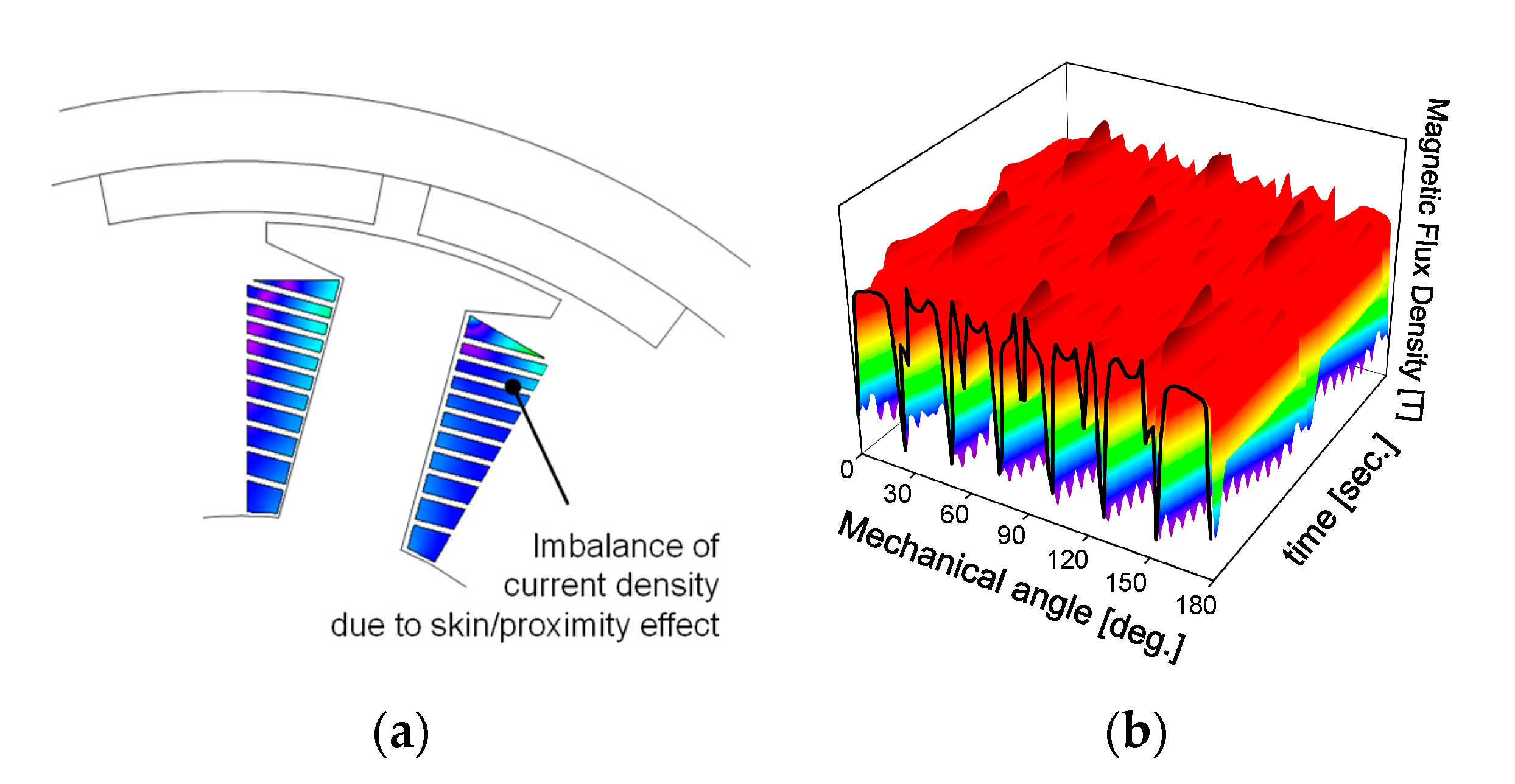
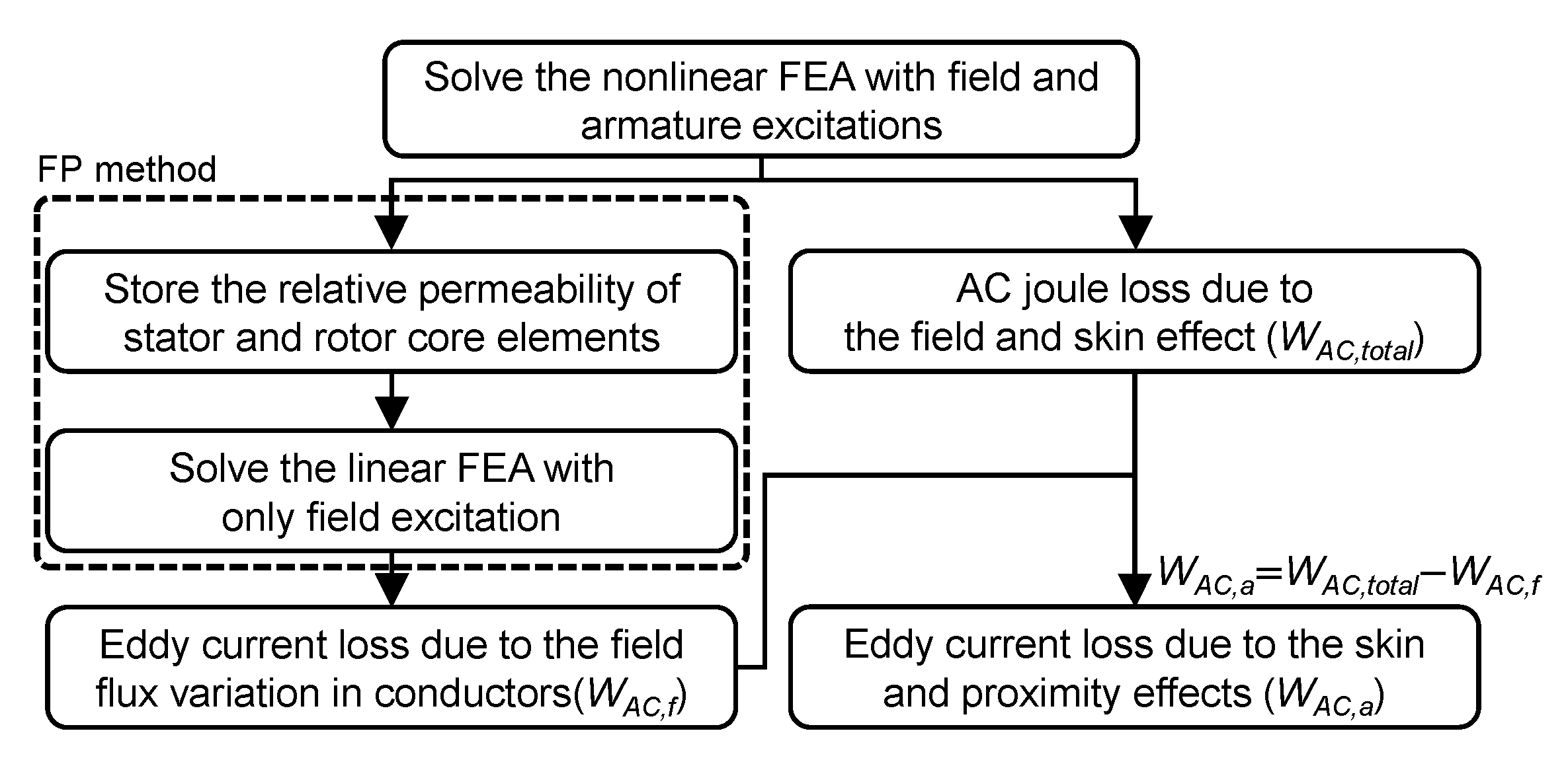

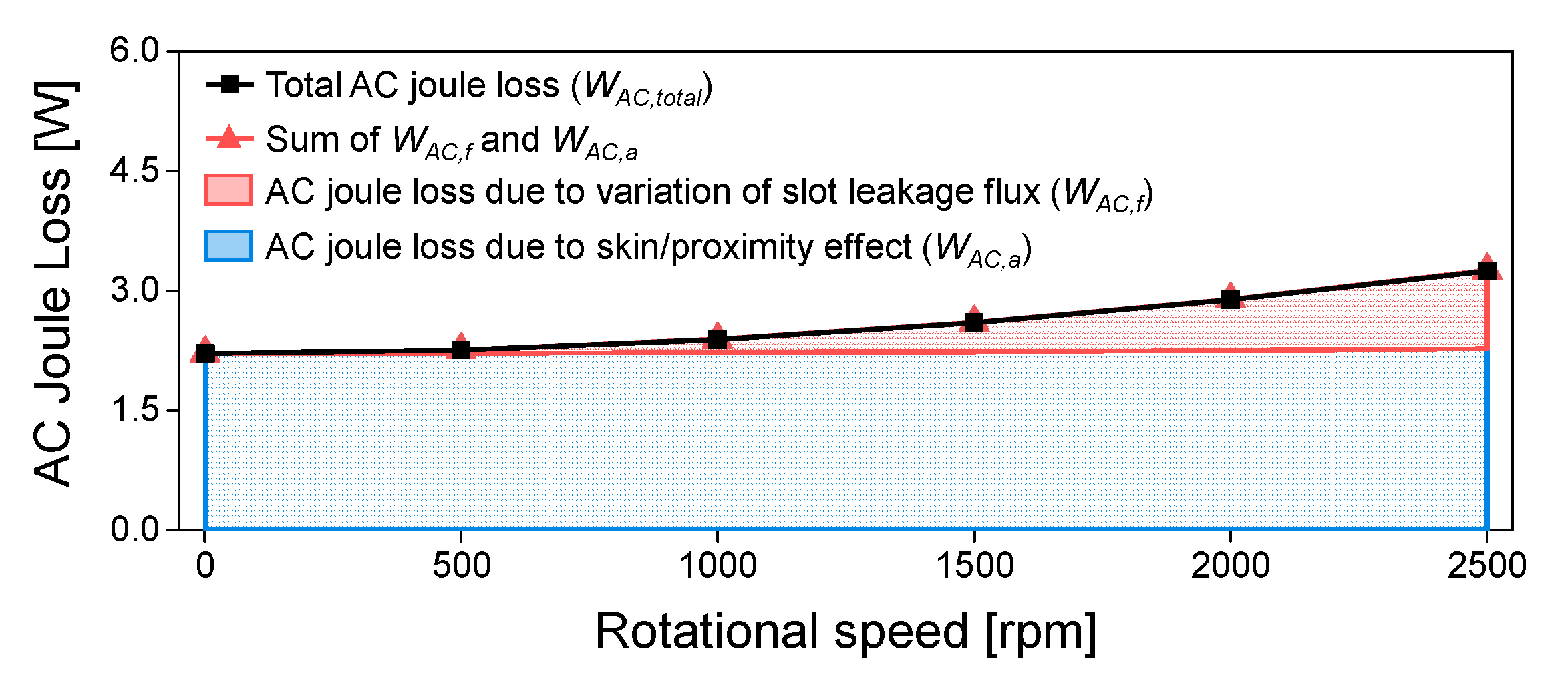
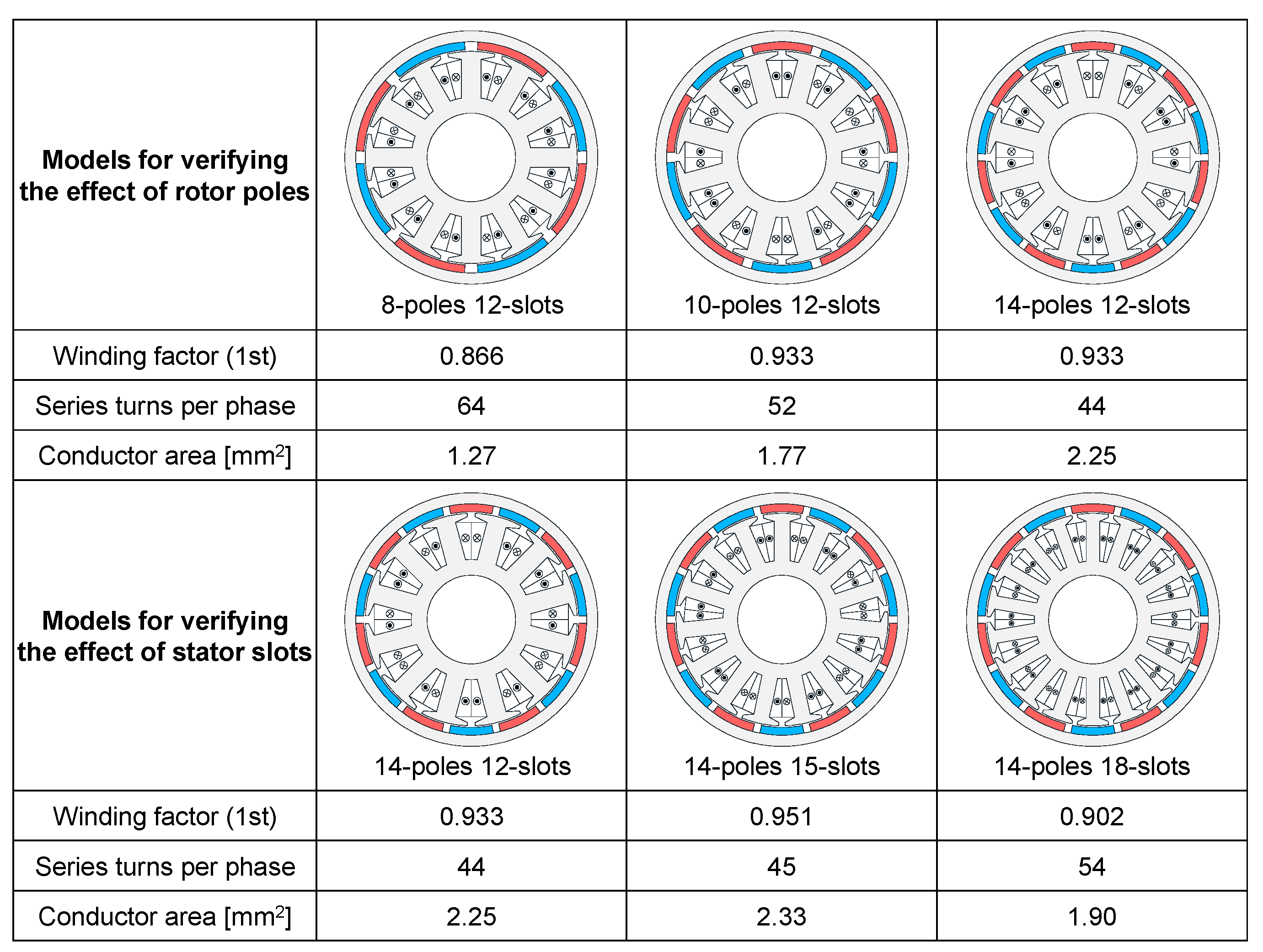

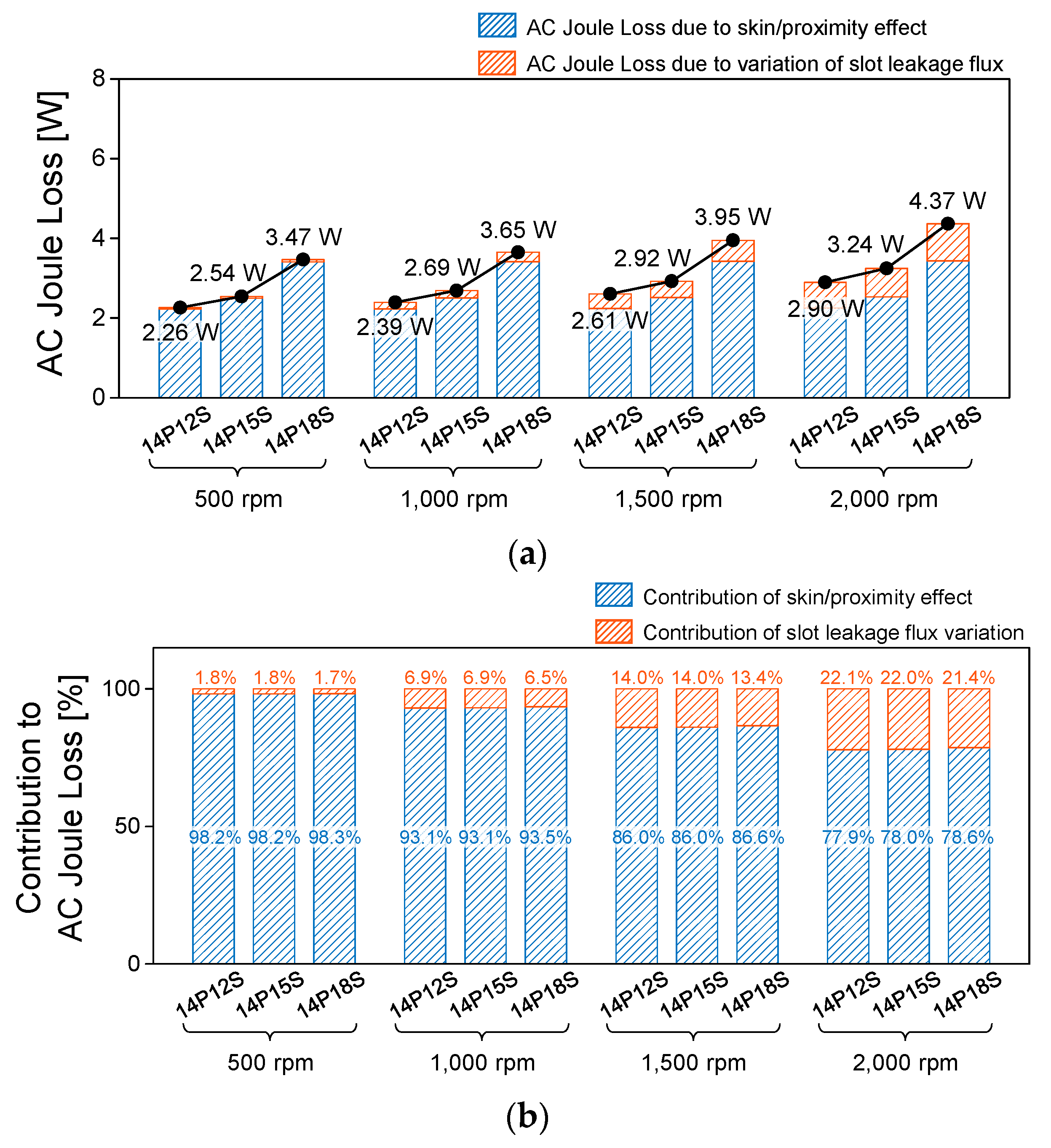
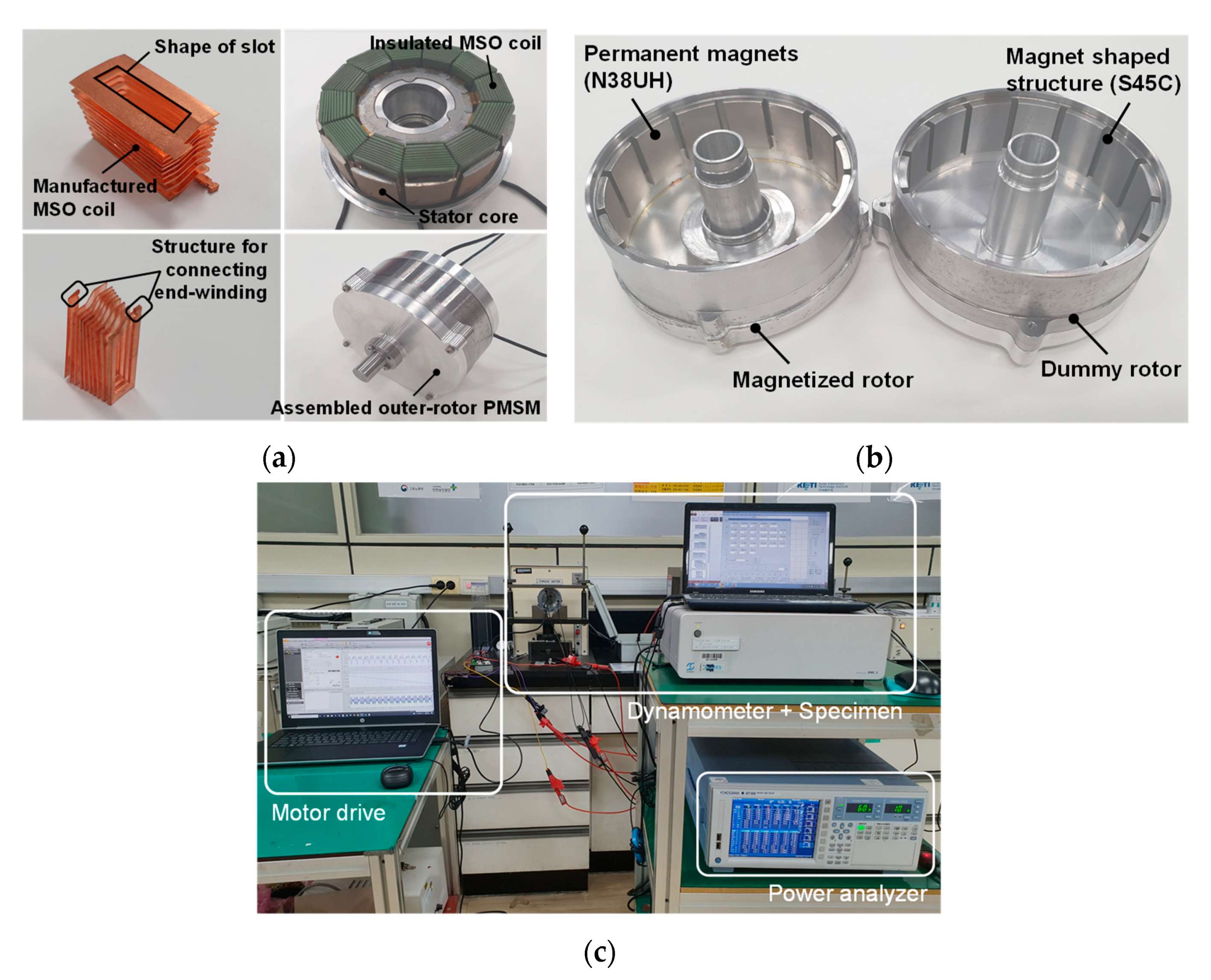
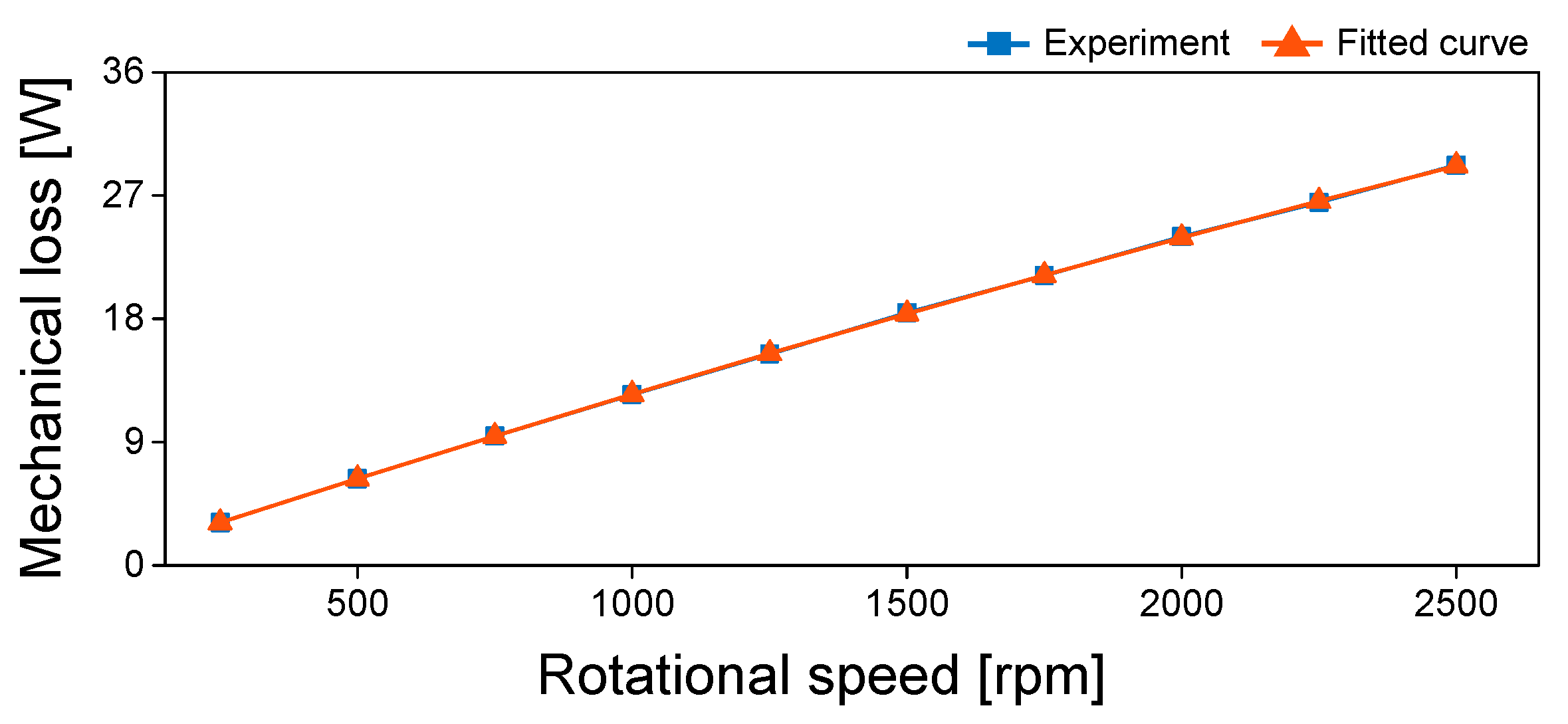
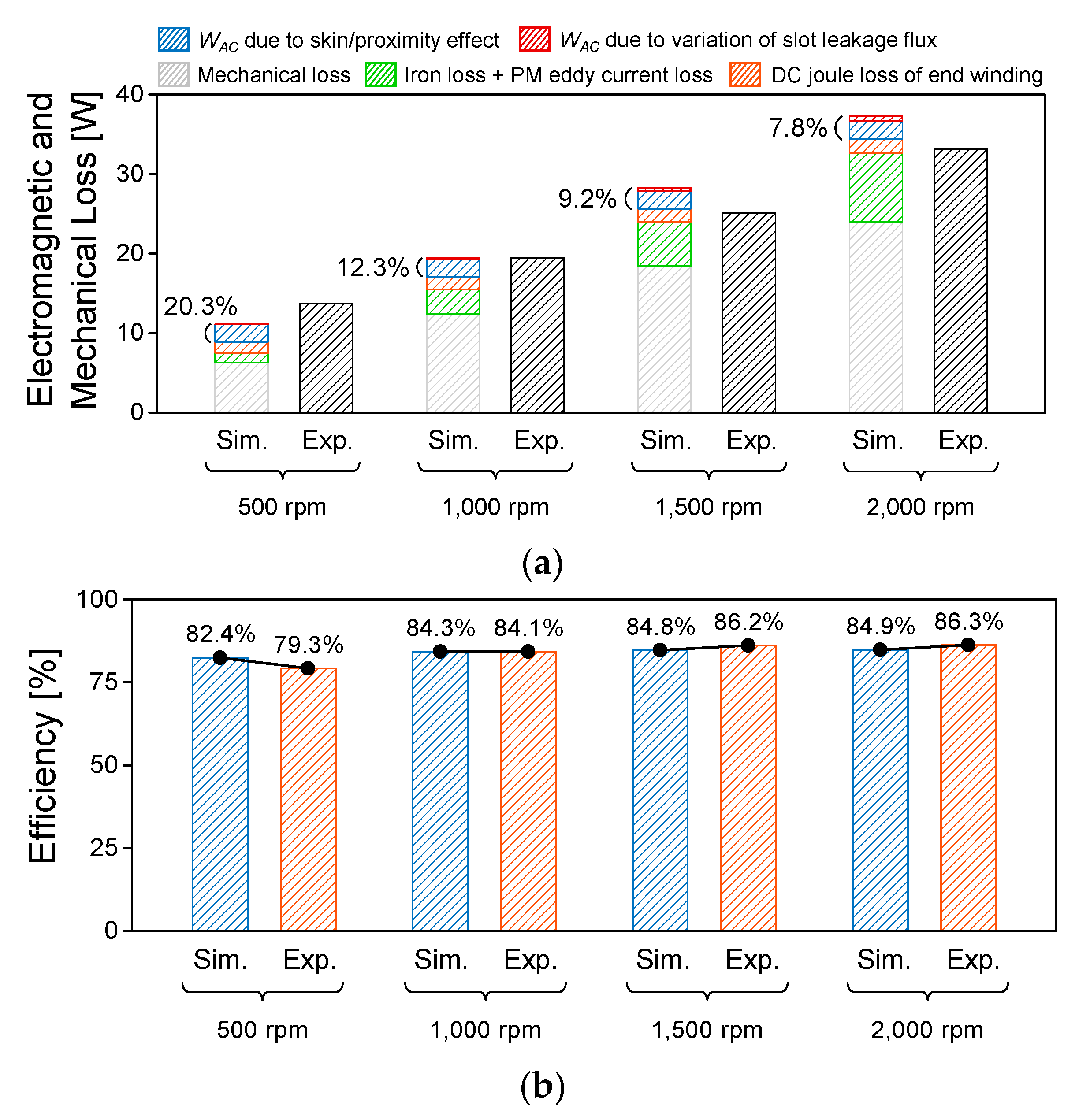
| Item | Unit | Value |
|---|---|---|
| Number of poles | - | 14 |
| Number of slots | - | 12 |
| Stator diameter | mm | 80 |
| Rotor diameter | mm | 67 |
| Stack length | mm | 20.7 |
| DC link voltage | V | 48 |
| Max. speed | rpm | 2500 |
| Rated torque | Nm | 1.0 |
| Permanent magnets | - | N38UH |
Publisher’s Note: MDPI stays neutral with regard to jurisdictional claims in published maps and institutional affiliations. |
© 2021 by the authors. Licensee MDPI, Basel, Switzerland. This article is an open access article distributed under the terms and conditions of the Creative Commons Attribution (CC BY) license (https://creativecommons.org/licenses/by/4.0/).
Share and Cite
Park, S.-H.; Lee, E.-C.; Lee, G.-J.; Kwon, S.-O.; Lim, M.-S. Effect of Pole and Slot Combination on the AC Joule Loss of Outer-Rotor Permanent Magnet Synchronous Motors Using a High Fill Factor Machined Coil. Energies 2021, 14, 3073. https://doi.org/10.3390/en14113073
Park S-H, Lee E-C, Lee G-J, Kwon S-O, Lim M-S. Effect of Pole and Slot Combination on the AC Joule Loss of Outer-Rotor Permanent Magnet Synchronous Motors Using a High Fill Factor Machined Coil. Energies. 2021; 14(11):3073. https://doi.org/10.3390/en14113073
Chicago/Turabian StylePark, Soo-Hwan, Eui-Chun Lee, Gi-Ju Lee, Soon-O. Kwon, and Myung-Seop Lim. 2021. "Effect of Pole and Slot Combination on the AC Joule Loss of Outer-Rotor Permanent Magnet Synchronous Motors Using a High Fill Factor Machined Coil" Energies 14, no. 11: 3073. https://doi.org/10.3390/en14113073
APA StylePark, S.-H., Lee, E.-C., Lee, G.-J., Kwon, S.-O., & Lim, M.-S. (2021). Effect of Pole and Slot Combination on the AC Joule Loss of Outer-Rotor Permanent Magnet Synchronous Motors Using a High Fill Factor Machined Coil. Energies, 14(11), 3073. https://doi.org/10.3390/en14113073







